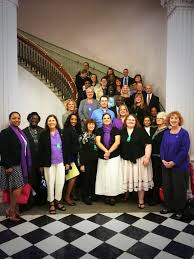Welcome to part 2 of our Inspirational Interview with Kristi VanAudenhove, Executive Director of the Virginia Sexual and Domestic Violence Action Alliance. In this part of her interview, Kristi talks about prevention work and the role of social justice advocacy.
You can read the first part of her interview and her full bio here
_____________________________________________________
![]()
6. Your team created a nationally recognised prevention/outreach campaign, the Red Flag Campaign. Can you tell us the impact this campaign has had in your area and across the United States?
The Red Flag Campaign was a great collaboration between our coalition and Virginia Commonwealth University (VCU) students. It remains an annual campaign that we continue to give to a group of Virginia colleges and universities at no cost every year.
The campaign is in every state now and colleges can purchase the campaign toolkit and posters to implement programmes at their school. The recipients agree to implement the campaign fully, evaluate it, and share results. Exciting things are happening with the campaign as it continues to evolve. For example: VCU has received funding from the Avon Foundation to do a more intensive evaluation on the real impact of the campaign.
Editor’s note: The Red Flag Campaign is a public awareness campaign designed to address dating violence and promote the prevention of dating violence on college campuses. The campaign was created using a “bystander intervention” strategy, encouraging friends and other campus community members to “say something” when they see warning signs (“red flags”) for dating violence in a friend’s relationship. The campaign posters reflect racially and ethnically diverse models, and illustrate both heterosexual and same-sex relationships.
7. The Action Alliance has been focusing on prevention work over the last few years. How has prevention work and prevention programmes translated to local centres and local communities? What are the successes and obstacles in prevention programmes over outreach campaigns?
Our concept of prevention is as part of the movement to go upstream to find and address the source of issues. What is different now is that we are now connected to the public health field of violence prevention overall that we can apply to intimate partner violence and sexual violence. We are finding more and more sexual and domestic violence agencies are wanting to be engaged in prevention programmes and want to invest in primary prevention in their communities. A small investment in primary prevention pays off as costing the community less in the long run.

8. Violence against women and girls is a social justice and human rights issue that seems particularly insidious and difficult to eradicate because it is so often part of cultural institutions and the accepted social norm. How do coalitions like yours, whose role is to support local centres through advocacy and training, directly address the role of culture in perpetuating violence against women and can these efforts change the cultures where this is the norm?
Think of the social norms we have worked to change over the last 30 years. Coalition work is about balancing and supporting local sexual and domestic violence agencies through training, funding, and advocacy. The other work we do is bringing leaders and advocates together to shift cultural norms and make big institutional changes. In today’s world it is becoming easier to see where we need to focus our work. Now we are getting to the majority of people in agreement that violence is not okay and that sexual behavior requires consent.
9. Over the past couple years, we have seen countless headlines of sexual attacks, in many different forms, on young girls. Famous public figures arrested for rape, gangs trafficking vulnerable teenage girls for sexual exploitation and a number of high profile cases of young girls raped and murdered by family members and friends they trusted. How can coalitions like yours support the work local centres do with their communities to respond to this?
One of the struggles that we have is that one case can get highlighted and the media and the community begins to focus on just that case but there are multiple cases not being talked about at all because those cases do not have the same access to media. For those in our society that have greater access to media, prosecutors, and other officials, their cases can get looked at first and have more time and resources spent on them to solve, leaving those cases without such access behind. It becomes the work of advocates to bring all the cases to light and to help centres prepare to respond.
10. Finally, in your considered opinion, how can we end violence against women today?
It’s hard for everyone to make that choice when we have built a country on violence and hierarchy. The notion that some people are more deserving than others of life, beauty and happiness is ingrained in our society and there is a fine line between patriotism and pride in our country and failure to recognise the rights and values of others from other countries. To a certain extent, violence against “somebody” is built into our culture and I would argue that we are not trying to end violence against women because it is not just violence against women and we cannot turn our backs on violence against other groups such as children, those who identify as LGBTQ or those who immigrate to the US. We are on a course correction since we put that mistake in writing and so we expand who has those rights continuously and that is the work that we must keep doing.